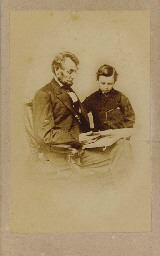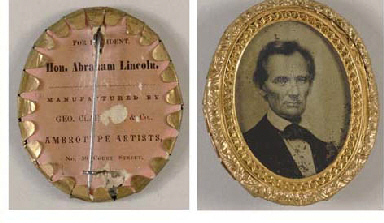LINCOLN, Abraham (1809-1865), President . BRADY, Matthew B., phototographer. Jumbo ambrotype campaign badge with oval portrait of Abraham Lincoln, [imprint on verso:] For President Hon. Abraham Lincoln Manufactured by Geo. Clark, Jr. & Co., Ambrotype Artists, No.59 Court St., Boston. [1860]. 2 5/8 x 2 1/8 in., including frame, oval ambrotype portrait on glass (1 7/16 x 1 7/8 in.), framed in broad decorative oval of stamped gilt metal, typographic back printed on pale blue card, back with large brass pin and clasp, very minor soiling to back panel, otherwise in superb condition, THE IMAGE ESPECIALLY RICH, CLEAR AND STRONG. The largest, rarest and, quite probably, most costly to produce of all early American political campaign badges. It was made in very limited quantities by a Boston shop during the key 1860 campaign, when the four-year old Republican party fielded an Illinois lawyer against three candidates of a Democratic party fatally divided over the issue of slavery. While the badge may have been used during the actual campaign, (summer and Fall, 1860), it is entirely possible that it may have been made even earlier (prior to May 1860), for use by the members of the influential Massachusetts state delegation to the Republican convention in Chicago. On May 18 that convention nominated Lincoln on the third ballot. The antecedents of this striking artifact date to Andrew Jackson's 1824 campaign, when small brass medallions bearing the image of "Old Hickory" were introduced. In subsequent Presidential contests various types of badges, medals and medalets proliferated. But it was during the crucial 1860 campaign that photographic processes were first employed to create these political badges. Introduced at this time was the ferrotype, a small tintype image inexpensively produced on metal and cased in a brass frame. These were evidently mass-produced in considerable quantities (see T. Hake, Hake's Guide to Presidential Campaign Collectibles , pp.88-89). The present jumbo ambrotype is a political artifact of an altogether superior order. For one thing, the ambrotype process (by which a positive image is rendered by backing a photographic negative on glass with a dark material) was sensitive, difficult and relatively expensive, precluding mass-production. George Clark a little-known Boston ambrotypist, chose to produce an large image (nearly twice the size of the more common ferrotypes), in an oval format, very much suggesting a miniature portrait. The process was quite labor-intensive: after Lincoln's image was transferred to specially-shaped glass discs and the specially-printed backing card had been cut to the same proportions, the delicate ambrotype and the printed card had to be assembled within the gilt metal frame. At this point, the stickpin was soldered in place (some copies have a hole at the top so they could be hung by a ribbon). The complexity of manufacture is a factor in the extreme rarity of Clark's jumbo ambrotype: fewer than 10 are likely to be extant, and at least one of those shows visible flaking or cracking of the image. The image used for the ambrotype is the famous Cooper Union portrait, the most famous of Lincoln's beardless poses, taken in New York city only hours before Lincoln was to deliver the Cooper Union address that brought him national prominence. "On Monday, February 27, escorted by several of the Young Republicans, he caught a glimpse of Broadway and had his photo, which he called his 'shaddow,' taken at Matthew B. Brady's studio...The portrait Brady produced after this sitting was a work of art; he retouched the negative in order to correct Lincoln's left eye that seemed to be roving upward and eliminated harsh lines from his face to show an almost handsome, statesmanlike image" (D. H. Donald, Lincoln , p.238). In Brady's portrait, Lincoln is wearing the $100 suit which he had specially ordered from a Springfield tailor to be worn for his highly publicized New York appearance. The memorab
LINCOLN, Abraham (1809-1865), President . BRADY, Matthew B., phototographer. Jumbo ambrotype campaign badge with oval portrait of Abraham Lincoln, [imprint on verso:] For President Hon. Abraham Lincoln Manufactured by Geo. Clark, Jr. & Co., Ambrotype Artists, No.59 Court St., Boston. [1860]. 2 5/8 x 2 1/8 in., including frame, oval ambrotype portrait on glass (1 7/16 x 1 7/8 in.), framed in broad decorative oval of stamped gilt metal, typographic back printed on pale blue card, back with large brass pin and clasp, very minor soiling to back panel, otherwise in superb condition, THE IMAGE ESPECIALLY RICH, CLEAR AND STRONG. The largest, rarest and, quite probably, most costly to produce of all early American political campaign badges. It was made in very limited quantities by a Boston shop during the key 1860 campaign, when the four-year old Republican party fielded an Illinois lawyer against three candidates of a Democratic party fatally divided over the issue of slavery. While the badge may have been used during the actual campaign, (summer and Fall, 1860), it is entirely possible that it may have been made even earlier (prior to May 1860), for use by the members of the influential Massachusetts state delegation to the Republican convention in Chicago. On May 18 that convention nominated Lincoln on the third ballot. The antecedents of this striking artifact date to Andrew Jackson's 1824 campaign, when small brass medallions bearing the image of "Old Hickory" were introduced. In subsequent Presidential contests various types of badges, medals and medalets proliferated. But it was during the crucial 1860 campaign that photographic processes were first employed to create these political badges. Introduced at this time was the ferrotype, a small tintype image inexpensively produced on metal and cased in a brass frame. These were evidently mass-produced in considerable quantities (see T. Hake, Hake's Guide to Presidential Campaign Collectibles , pp.88-89). The present jumbo ambrotype is a political artifact of an altogether superior order. For one thing, the ambrotype process (by which a positive image is rendered by backing a photographic negative on glass with a dark material) was sensitive, difficult and relatively expensive, precluding mass-production. George Clark a little-known Boston ambrotypist, chose to produce an large image (nearly twice the size of the more common ferrotypes), in an oval format, very much suggesting a miniature portrait. The process was quite labor-intensive: after Lincoln's image was transferred to specially-shaped glass discs and the specially-printed backing card had been cut to the same proportions, the delicate ambrotype and the printed card had to be assembled within the gilt metal frame. At this point, the stickpin was soldered in place (some copies have a hole at the top so they could be hung by a ribbon). The complexity of manufacture is a factor in the extreme rarity of Clark's jumbo ambrotype: fewer than 10 are likely to be extant, and at least one of those shows visible flaking or cracking of the image. The image used for the ambrotype is the famous Cooper Union portrait, the most famous of Lincoln's beardless poses, taken in New York city only hours before Lincoln was to deliver the Cooper Union address that brought him national prominence. "On Monday, February 27, escorted by several of the Young Republicans, he caught a glimpse of Broadway and had his photo, which he called his 'shaddow,' taken at Matthew B. Brady's studio...The portrait Brady produced after this sitting was a work of art; he retouched the negative in order to correct Lincoln's left eye that seemed to be roving upward and eliminated harsh lines from his face to show an almost handsome, statesmanlike image" (D. H. Donald, Lincoln , p.238). In Brady's portrait, Lincoln is wearing the $100 suit which he had specially ordered from a Springfield tailor to be worn for his highly publicized New York appearance. The memorab















Testen Sie LotSearch und seine Premium-Features 7 Tage - ohne Kosten!
Lassen Sie sich automatisch über neue Objekte in kommenden Auktionen benachrichtigen.
Suchauftrag anlegen